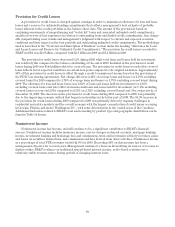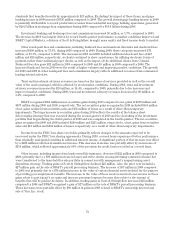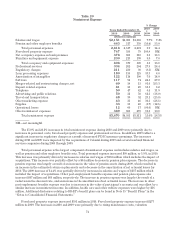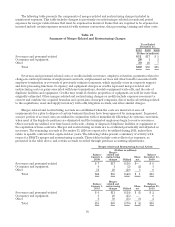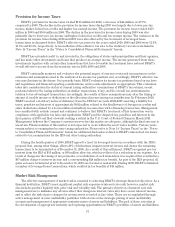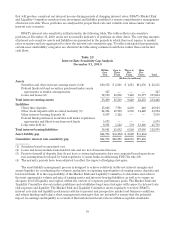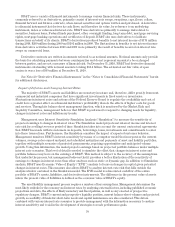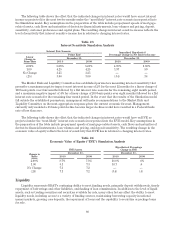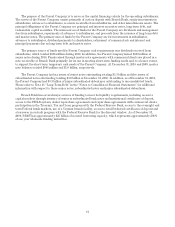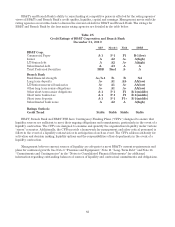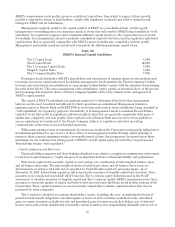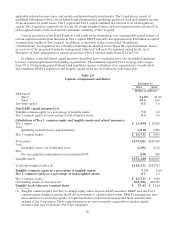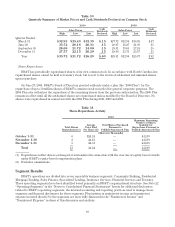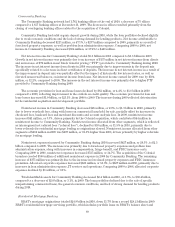BB&T 2010 Annual Report Download - page 79
Download and view the complete annual report
Please find page 79 of the 2010 BB&T annual report below. You can navigate through the pages in the report by either clicking on the pages listed below, or by using the keyword search tool below to find specific information within the annual report.BB&T uses a variety of financial instruments to manage various financial risks. These instruments,
commonly referred to as derivatives, primarily consist of interest-rate swaps, swaptions, caps, floors, collars,
financial forward and futures contracts, when-issued securities and options written and purchased. A derivative
is a financial instrument that derives its cash flows, and therefore its value, by reference to an underlying
instrument, index or referenced interest rate. BB&T uses derivatives primarily to manage risk related to
securities, business loans, Federal funds purchased, other overnight funding, long-term debt, mortgage servicing
rights, mortgage banking operations and certificates of deposit. BB&T also uses derivatives to facilitate
transactions on behalf of its clients. BB&T’s derivatives produced benefits to net interest income of $175 million
during 2010, $209 million during 2009 and $101 million in 2008. The fluctuations in benefits to net interest income
from derivative activities between 2010 and 2009 were primarily the result of benefits received on interest rate
swaps on commercial loans.
Derivative contracts are written in amounts referred to as notional amounts. Notional amounts only provide
the basis for calculating payments between counterparties and do not represent amounts to be exchanged
between parties, and are not a measure of financial risk. On December 31, 2010, BB&T had derivative financial
instruments outstanding with notional amounts totaling $65.4 billion. The estimated net fair value of open
contracts was a loss of $69 million at December 31, 2010.
See Note 20 “Derivative Financial Instruments” in the “Notes to Consolidated Financial Statements” herein
for additional disclosures.
Impact of Inflation and Changing Interest Rates
The majority of BB&T’s assets and liabilities are monetary in nature and, therefore, differ greatly from most
commercial and industrial companies that have significant investments in fixed assets or inventories.
Fluctuations in interest rates and actions of the Federal Reserve Board to regulate the availability and cost of
credit have a greater effect on a financial institution’s profitability than do the effects of higher costs for goods
and services. Through its balance sheet management function, which is monitored by the Market Risk and
Liquidity Committee, management believes that BB&T is positioned to respond to changing needs for liquidity,
changes in interest rates and inflationary trends.
Management uses Interest Sensitivity Simulation Analysis (“Simulation”) to measure the sensitivity of
projected earnings to changes in interest rates. The Simulation model projects net interest income and interest
rate risk for a rolling two-year period of time. Simulation takes into account the current contractual agreements
that BB&T has made with its customers on deposits, borrowings, loans, investments and commitments to enter
into those transactions. Furthermore, the Simulation considers the impact of expected customer behavior.
Management monitors BB&T’s interest sensitivity by means of a computer model that incorporates the current
volumes, average rates earned and paid, and scheduled maturities and payments of asset and liability portfolios,
together with multiple scenarios of projected prepayments, repricing opportunities and anticipated volume
growth. Using this information, the model projects earnings based on projected portfolio balances under multiple
interest rate scenarios. This level of detail is needed to simulate the effect that changes in interest rates and
portfolio balances may have on the earnings of BB&T. This method is subject to the accuracy of the assumptions
that underlie the process, but management believes that it provides a better illustration of the sensitivity of
earnings to changes in interest rates than other analyses such as static or dynamic gap. In addition to Simulation
analysis, BB&T uses Economic Value of Equity (“EVE”) analysis to focus on changes in capital given potential
changes in interest rates. This measure also allows BB&T to analyze interest rate risk that falls outside the
analysis window contained in the Simulation model. The EVE model is a discounted cash flow of the entire
portfolio of BB&T’s assets, liabilities, and derivatives instruments. The difference in the present value of assets
minus the present value of liabilities is defined as the economic value of BB&T’s equity.
The asset/liability management process requires a number of key assumptions. Management determines the
most likely outlook for the economy and interest rates by analyzing external factors, including published economic
projections and data, the effects of likely monetary and fiscal policies, as well as any enacted or prospective
regulatory changes. BB&T’s current and prospective liquidity position, current balance sheet volumes and projected
growth, accessibility of funds for short-term needs and capital maintenance are also considered. This data is
combined with various interest rate scenarios to provide management with the information necessary to analyze
interest sensitivity and to aid in the development of strategies to reach performance goals.
79


